Translate this page into:
Molecular Mechanisms and Pathophysiology of Anxiety and Depression: A Comprehensive Bibliometric Analysis (1960–2023)

*Corresponding author: Sridhar Amalakanti, Department of Neurology, All India Institute of Medical Sciences Mangalagiri, Mangalagiri, Andhra Pradesh, India sridhar@aiimsmangalagiri.edu.in
-
Received: ,
Accepted: ,
How to cite this article: Avula VCR, Amalakanti S, Shashidhara M. Molecular Mechanisms and Pathophysiology of Anxiety and Depression: A Comprehensive Bibliometric Analysis (1960–2023). Bengal J Psychiatry. doi: 10.25259/BJPSY_2_2025
Abstract
Introduction
Anxiety and depressive disorders are prevalent mental health conditions with complex molecular underpinnings.
Objectives
This study aims to provide a comprehensive overview of molecular research in anxiety and depression from 1960 to 2023.
Material and Methods
A bibliometric analysis was conducted using data from Web of Science and Scopus databases. The study employed various bibliometric techniques, including performance analysis, science mapping, and network analysis.
Results
The analysis revealed 7791 relevant documents from 2237 sources, with an annual growth rate of 9.54%. The United States emerged as the leading contributor, with the University of California being the most common affiliation. Key research themes included brain function, depression mechanisms, and gene expression, with an emerging focus on inflammatory pathways.
Conclusion
This bibliometric analysis highlights the evolution and current state of molecular research in anxiety and depression, identifying key trends, collaborations, and potential areas for future investigation.
Keywords
Anxiety
Bibliometric analysis
Depression
Mental health
Molecular mechanisms
Neuroscience
Pathophysiology
INTRODUCTION
Anxiety and depressive disorders are the most common mental health disorders, with a 4.05% and 3.8% prevalence, respectively. Anxiety touches 301 million lives, resulting in 28.7 million years lived with disability (YLD), while depression affects 280 million individuals, accounting for 46.9 million YLD.1,2
Multiple genes with modest effects and environmental factors have been linked to the causation of depression and anxiety. In unipolar depression, research has focused on serotonergic system genes such as tyrosine hydroxylase, serotonin (5HT) transporter, and 5-HT2C receptor.3–5 The evidence for the role of the dopaminergic system is supported by the effectiveness of bupropion, a dopamine agonist, in the treatment of depression.6 N-methyl-D-aspartate receptor antagonist ketamine’s rapid antidepressant effects have drawn attention to glutamatergic pathways in mood regulation.7 Impaired serotonin, norepinephrine, and dopaminergic secretion; presynaptic receptor binding affinity; and variation in genomic transcription of serotonin receptors have been implicated in depression.8 Another important finding is that inflammatory markers IL-1β, IL-6, and TNF-α (interleukin )(tumor necrosis factor) are elevated in depression, and the prevalence of depression is higher in diseases with autoimmunity showing elevated levels.9
Genetic variations in the serotonin transporter gene (5HTT) are associated with an increased risk of depression, further impacting serotonin function and contributing to mood disorders.10,11 Additionally, a recent meta-analysis has found that Val66Met polymorphisms of the brain-derived neurotrophic factor and environmental stressors are associated with depression.12,13 Recent findings indicate that the interleukin 1 beta gene, located at locus 2q14.1, has two single nucleotide polymorphisms (SNPs) linked to depression: rs1143627 (−31T/C) and rs16944 (−511C/T). The rs16944 SNP has been associated with a response to treatment, while rs1143627 has been linked to recurrent depression.14,15 Additionally, the rs25532 SNP in the 5-Hydroxytryptamine Transporter Length Polymorphic Region (5HTTLPR) area is associated with Obsessive-Compulsive Disorder (OCD).16 OCD is also related to the serotonin transporter gene I425V alterations involving inositol and valine.17
Prominent genetic studies in anxiety disorders include the examination of the 5HTTLPR polymorphism of the Solute Carrier Family 6 Member 4, the val158met polymorphism (rs4680) of Catechol-O-methyltransferase (COMT), a promoter length polymorphism in Monoamine Oxidase A, and the Regulator of G-protein Signaling 2 variant (rs4606).18 A decreased expression of the 5HTTLPR genotype is associated with a rapid response within 1 week of treatment for panic disorder in adults and other anxiety disorders in children.19 Furthermore, the COMT’s rs4680 variation has shown promise in the treatment of generalized anxiety disorder with venlafaxine.20
Epigenetic studies focusing on the methylation of 480,000 cytosine residues have found lower methylation in patients with panic disorder at 40 CpG sites.21,22 In a large cohort study (N = 1522), increased deoxyribonucleic acid (DNA) methylation at a single CpG site in the Ankyrin Repeat And suppressor of cytokine signalling (SOCS) Box Containing 1 gene’s promoter correlated with high anxiety levels.23 Genome-wide association Studies have extensively researched panic disorder, identifying the TMEM132D gene as a particularly relevant marker in Europeans, predicting 7%–17% heritability from common SNPs. This method also identified phosphodiesterase 4B as an anxiety-related gene.24
This bibliometric analysis aims to provide a comprehensive overview of molecular research in anxiety and depression over the past six decades. Specifically, it seeks to map the evolution of this field from 1960 to 2023, tracing the development of key concepts, methodologies, and findings.
MATERIAL AND METHODS
Research Question and Database
The present bibliometric analysis was undertaken with the research question, “What are the research trends in the pathophysiology of anxiety and depression?.” Web of Science (WOS) was the database chosen to retrieve the relevant articles on the research question. The authors undertook a comparative evaluation of the quantity and availability of the relevant data for the bibliometric analysis between the records obtained from databases such as WOS, Scopus, PubMed, and Embase. WOS enabled the fields’ maximum coverage for the bibliometric analysis [Figure S1]. It also harbors high-quality articles published in the medical sciences. WOS contains 2.2 billion+ citations from 196 million+ records across 34,000+ peer-reviewed journals, 300,000 conferences, 134,000+ books, 14.5 million+ data sets and studies, 109 million+ patent documents, and 2.5 million+ preprints, including 254 subject categories since 1864.25 Hence, WOS was finalized for retrieving the relevant records for the analysis.
Figure S1:
Figure S1:Comparative number of relevant manuscripts in the different databases.Search Strategy
The systematic search was undertaken on 13 August 2023 using the keywords “depressive disorder*,” “anxiety,” “molecular,” and “pathophysiology.” The exact search strategy adopted for the search in the WOS is given in Table S1. The search yielded 2592 relevant results.
Table S1:
Table S1:Search query and the results obtained from WOS database (Date: 13th August 2023).Data Used in the Analysis
The following fields were available from the retrieved results: title of the study, author, document type, journal, language, number of cited references, year of the publication, total citations, cited references, affiliations of the authors, corresponding author, abstract, digital object identifier, keywords, and keyword plus.
Bibliometric Techniques and Analyses
The present analysis included both main and enrichment techniques under the bibliometric analysis. Publication-related metrics, and citation-related metrics, a combination of both were included under the performance analysis, while citations, co-citation, co-word, and co-authorship analysis were included under the science mapping category. Network analysis was undertaken as a part of the enrichment method. Primary information regarding the bibliometric data was presented regarding the performance indicators. We presented the citation analysis, co-citation analysis, bibliometric coupling, and co-word analysis (co-occurrence).26 Three-field plot, country collaboration network, most cited countries, most cited document, most relevant affiliation, most relevant authors, corresponding author’s countries, most relevant sources (journal), conceptual structure maps, topic dendrograms, thematic map, and word clouds were also depicted in the study.27
Analysis
Bibliometric analysis was carried out in R Studio and Biblioshiny, the web interface of R Studio. The Bibliometrix R package, along with its accessible web platform Biblioshiny, offers a complete range of methods and is frequently utilized for bibliometric evaluations. In recent years, the R programming language has become a popular tool for conducting such analyses, with the Bibliometrix R package emerging as a prominent choice among researchers. This package facilitates comprehensive bibliometric evaluations, offering various techniques to analyze scientific literature data.28
RESULTS
Descriptive Analysis of the Field
The WOS and Scopus database search revealed 7791 unique records, which were used to undertake the bibliometrics in this research domain. The study period ranged from 1960 to 2023, with a mean growth rate of 9.54% annually [Table 1].
| Category | Sub-category | Results |
| Main Information About Data | Timespan | 1960:2023 |
| Sources (Journals, Books, etc.) | 2237 | |
| Documents | 7791 | |
| Annual Growth Rate % | 9.54 | |
| Document Average Age | 8.53 | |
| Average Citations Per Doc | 47.96 | |
| References | 53480 | |
| Document Contents | Keywords Plus (Id) | 39241 |
| Author’s Keywords (DE) | 14340 | |
| Authors | Authors | 30403 |
| Authors Of Single-Authored Docs | 583 | |
| Authors Collaboration | Single-Authored Docs | 661 |
| Co-Authors Per Doc | 6.11 | |
| International Co-Authorships % | 2.362 | |
| Document Types | Article | 4488 |
| Article: Article | 26 | |
| Article: Editorial | 1 | |
| Article: Review | 14 | |
| Article; Early Access | 3 | |
| Article: Proceedings Paper | 10 | |
| Article: Retracted Publication | 2 | |
| Book | 16 | |
| Book Chapter | 229 | |
| Conference Paper | 108 | |
| Data Paper | 1 | |
| Editorial | 67 | |
| Editorial Material | 8 | |
| Erratum | 1 | |
| Letter | 36 | |
| Meeting Abstract | 1 | |
| Note | 36 | |
| Note Article | 1 | |
| Retracted | 4 | |
| Review | 2667 | |
| Review Article | 18 | |
| Review | 12 | |
| Review: Book Chapter | 2 | |
| Review: Early Access | 1 | |
| Short Survey | 39 | |
| Sources (Journals) | International Journal of Molecular Sciences | 155 |
| Category | Sub-category | Results |
| Molecular Psychiatry | 122 | |
| PLoS One | 119 | |
| Translational Psychiatry | 92 | |
| Behavioral Brain Research | 90 | |
| Biological Psychiatry | 90 | |
| Molecular Neurobiology | 83 | |
| Neuroscience and Bio-behavioral Reviews | 74 | |
| Scientific Reports | 69 | |
| Neuropharmacology | 67 | |
| Affiliation | University of California | 248 |
| University of Toronto | 193 | |
| Harvard Medical School | 172 | |
| Icahn School of Medicine at Mount Sinai | 129 | |
| University of Pittsburgh | 100 | |
| Chongqing Medical University | 93 | |
| University of Pennsylvania | 91 | |
| University of Melbourne | 85 | |
| Max Planck Institute of Psychiatry | 84 | |
| National Institute of Mental Health | 83 | |
| Most Cited Region | USA | 2877 |
| China | 1270 | |
| Germany | 572 | |
| Italy | 508 | |
| UK | 448 | |
| Canada | 426 | |
| Japan | 382 | |
| France | 345 | |
| India | 260 | |
| Brazil | 250 | |
| Most Global Cited Docs | Brook Rd, 2010, Circulation | 4441 |
| Selkoe Dj, 2016, Embo Mol Med | 3459 | |
| Krishnan V, 2008, Nature | 2125 | |
| Kiernan Mc, 2011, Lancet | 1885 | |
| Beaulieu Jm, 2011, Pharmacol Rev | 1856 | |
| Lee Sh, 2013, Nat Genet | 1639 | |
| Paoletti P, 2013, Nat Rev Neurosci | 1619 | |
| Tsankova Nm, 2006, Nat Neurosci | 1475 | |
| Wang R, 2012, Physiol Rev | 1454 | |
| Biederman J, 2005, Lancet | 1418 |
DE: Descriptors.
The strength of the keywords reported in the records regarding frequency of occurrence and their co-occurrence with other keywords is depicted in Figure 1. Brain, depression, expression, and prefrontal cortex are the major research sub-domains within this concept, as visualized from the word cloud in Figure 2.19 While the term “brain” appears to be the most common, the terms “expression” and “depression” appear equally. The terms related to the molecular mechanisms, such as “messenger-ribonucleic acid (RNA) expression,” “genome-wide association,” and “gene expression,” have appeared relatively less in the records on this topic.
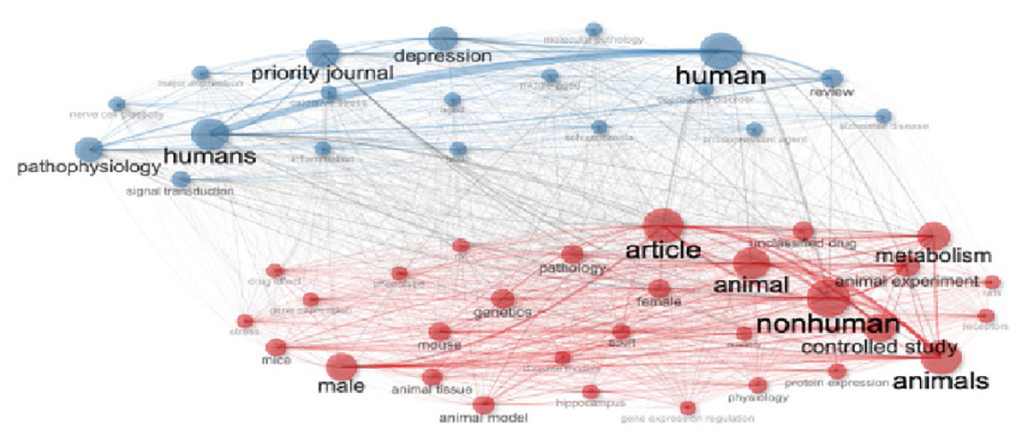
- Co-occurrence network for molecular mechanisms and pathophysiology of anxiety and depression.
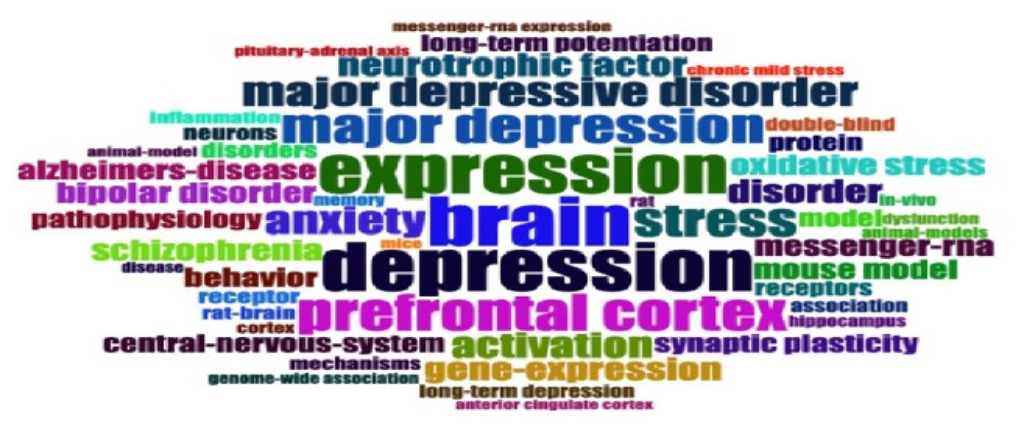
- Word cloud for molecular mechanisms and pathophysiology of anxiety and depression.
We have categorized the keyword co-occurrences and their clustering in Figure 3. We found two major clusters of keywords, with none of the keywords appearing to be common between them. In terms of impact and centrality, the cluster dealing with prefrontal cortex, mood disorders, and major depression scored better than the cluster with the keywords pathophysiology, brain, and stress.
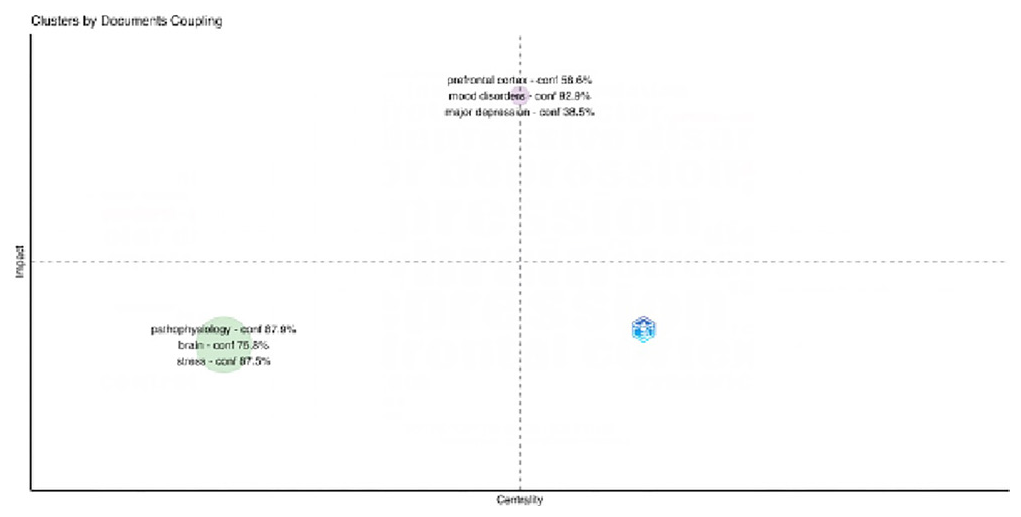
- Clustering of keywords for molecular mechanisms and pathophysiology of anxiety and depression.
The USA was the most productive country in this research domain. Figure 4 also allows us to see each nation’s research efforts in molecular mechanisms and pathophysiology of anxiety and depression. There has been considerable collaboration between the eastern and western hemisphere countries, indicating a global perspective in this research domain.
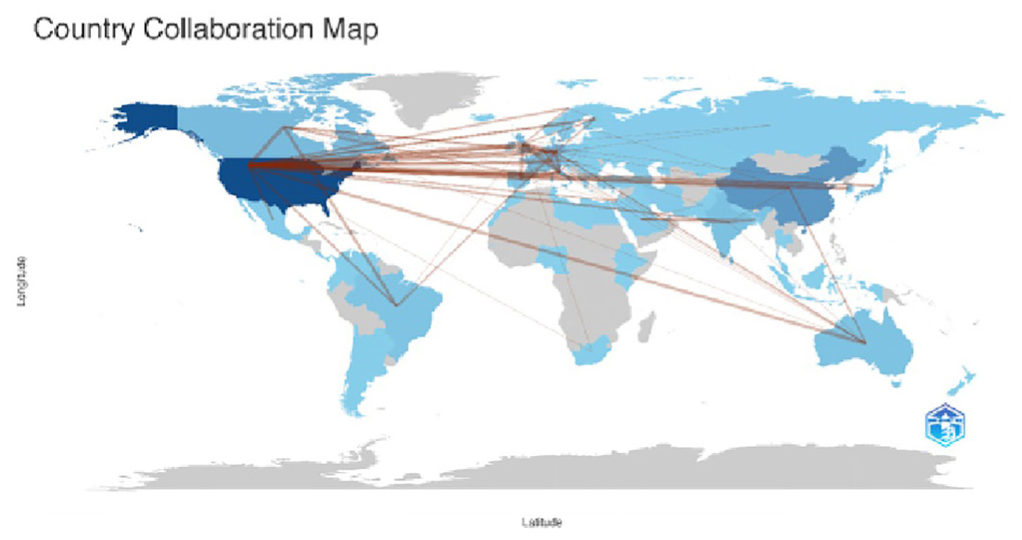
- Collaboration between countries for molecular mechanisms and pathophysiology of anxiety and depression.
In line with the overall affiliations, the USA topped the list of countries with the highest number of corresponding authors in the research [Figure 5] published in this research, both in single-country and multi-country publications.
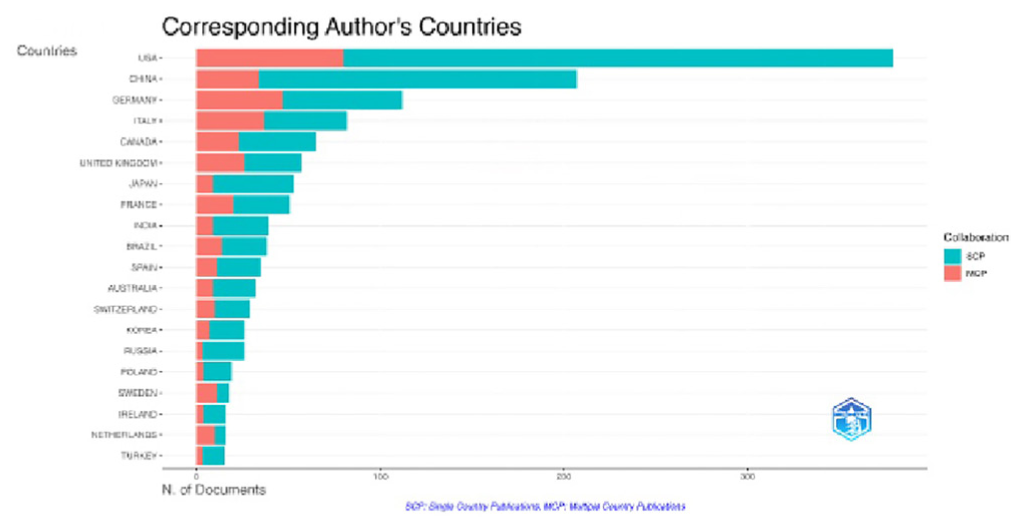
- Corresponding author countries for molecular mechanisms and pathophysiology of anxiety and depression.
Figure 6 represents the thematic map of the terms in this field. Brain, depression, and expression formed the basic themes of this field, while NF-kappa-B, c-reactive protein, and necrosis factor-alpha were under the niche themes. These niche themes should be linked with the ongoing discourse in the domain of molecular mechanisms and the pathophysiology of anxiety and depression. No exclusive motor or emerging/declining themes could be found. The prefrontal cortex, major depression, and major depressive disorder occupied the center of the spectrum, with no single primary type of theme.
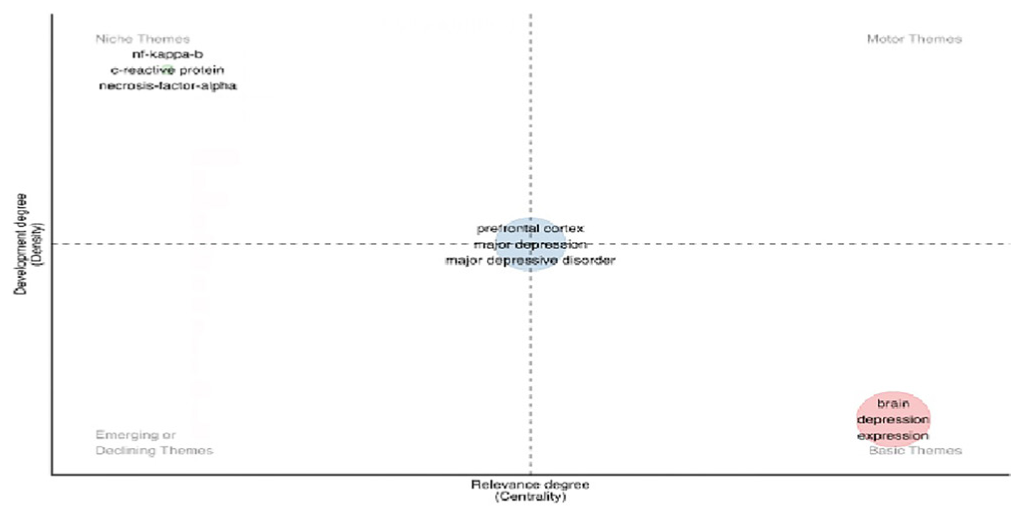
- Thematic map for molecular mechanisms and pathophysiology of anxiety and depression.
A common technique in bibliometric studies is co-citation analysis [Figure 7].29 In the present field of research, we found seven clusters of records built upon past research.
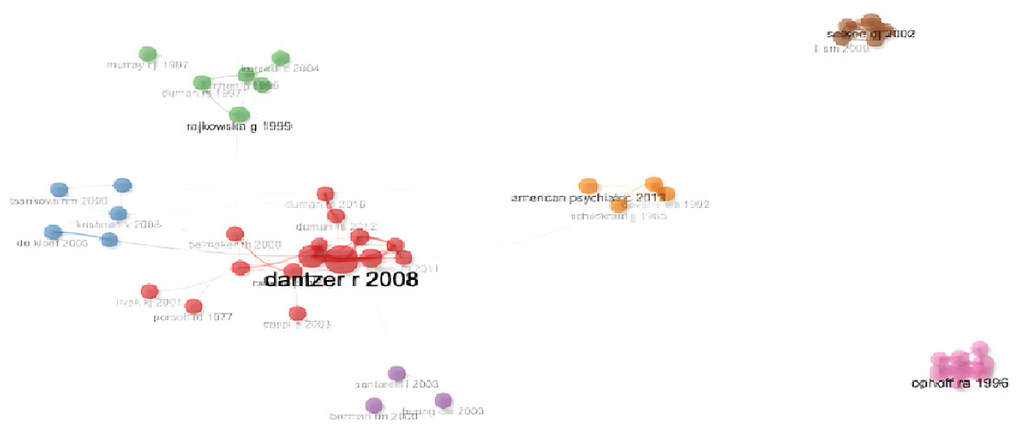
- Co-citation network for molecular mechanisms and pathophysiology of anxiety and depression.
DISCUSSION
The bibliometric analysis of the molecular mechanisms and pathophysiology of anxiety and depression provides crucial insights into the evolution and current status of research in the field. From 1960 to 2023, with 7791 documents sourced from 2237 different sources, the annual growth rate of 9.54% indicates a robust and active field and suggests research’s increasing interest and relevance in the molecular underpinnings of mood disorders. This is consistent with a bibliometric study of neuroscience that also showed a significant growth in the number of publications. With almost eight decades worth of studies under review, significant progress and expansion of knowledge in this field have been made.
The high number of citations for these documents indicates their significant impact on the field. This is similar to other bibliometric studies that identify the most influential articles in the field.30
The large number of keywords and authors indicates a diverse and multi-disciplinary field. This is similar to other bibliometric studies in neuroscience, highlighting the diversity of research topics and contributors.30 Most of the documents are articles and reviews, which is typical in scientific research. The finding that the “International Journal of Molecular Sciences,” “Molecular Psychiatry,” and “PLOS One” were the top three sources of records on molecular mechanisms and the pathophysiology of anxiety and depression reflects the significant impact and leading role of these journals in advancing research on mental health disorders. This aligns with other bibliometric analyses in related fields, where high-impact, multi-disciplinary journals often dominate due to their broad appeal and high-quality publications. The prominence of these journals also indicates a balanced focus on both molecular-level investigations (as seen in the “International Journal of Molecular Sciences”) and clinical and translational research (as in “Molecular Psychiatry”). Compared to earlier bibliometric studies, such as Yeung et al., which highlighted similar high-impact neuroscience journals, this finding suggests a continuous and increasing integration of molecular and clinical research. The presence of “PLOS One,” a generalist journal, further indicates that open-access platforms are increasingly vital for disseminating research in mental health, ensuring a wide and diverse readership. Implications include the growing importance of interdisciplinary approaches and open-access journals in shaping the future of molecular psychiatry and mental health research. This trend might encourage future research to continue prioritizing open and accessible platforms for global collaboration and knowledge exchange.30
The global spread of affiliations and the high number of citations from the USA, China, Germany, Italy, and the UK indicate the research’s global impact. This is consistent with other bibliometric studies showing an international spread of neuroscience research.
The prominence of the USA in citations, contributions, and collaborations emphasizes the country’s role as a global leader in neuropsychiatric research. This is further highlighted by institutions like the University of California leading the affiliations. Furthermore, collaborations between Eastern and Western Hemisphere countries suggest a global understanding and consensus on the importance of understanding anxiety and depression at the molecular level.
The analysis of keyword strength and co-occurrence, as depicted in Figure 2, reveals two major clusters, with the terms “human,” “depression,” and “pathophysiology” boldly depicted in one cluster, indicating a focus on clinical and human-centered research. The second cluster, connected to the first, prominently features terms like “article,” “animal,” “non-human,” and “metabolism,” reflecting a strong emphasis on preclinical and experimental studies. The connection between these clusters highlights the integration of clinical and animal research in exploring the molecular mechanisms of anxiety and depression. This pattern is consistent with findings in other bibliometric analyses, such as Cahlik’s study, which also identified distinct yet interconnected research themes in neuroscience. The linkage between human and animal studies suggests a multi-disciplinary approach, bridging molecular research in non-human models with clinical pathophysiological insights in humans. This co-occurrence network implies that future research could benefit from deeper exploration into how findings from animal models translate to human conditions, particularly regarding metabolism and molecular pathways. Strengthening these connections may lead to more targeted and effective therapeutic strategies.29
However, it is notable that while terms such as “brain,” “depression,” and “expression” are at the forefront of the research, molecular terms like “messenger-RNA expression” and “genome-wide association” appear less frequently. This could suggest that while the understanding of the broader neurological context of anxiety and depression has grown, there’s a need for more intricate molecular investigations.
The categorization of keyword co-occurrences and their clustering in Figure 3 reveals two distinct clusters with no overlapping keywords. The first cluster, encompassing “prefrontal cortex,” “mood disorders,” and “major depression,” exhibits higher impact and centrality, indicating a more influential and interconnected research focus on the neural and clinical aspects of mood disorders. In contrast, the second cluster, which includes “pathophysiology,” “brain,” and “stress,” appears less central, suggesting a more fragmented approach to understanding the underlying biological mechanisms. This bifurcation aligns with other bibliometric studies, such as Yeung et al., which also identified prominent clusters centered around specific neural regions and clinical conditions within neuroscience research. The dominance of the first cluster underscores the importance of targeting the prefrontal cortex in therapeutic interventions for major depression, while the second cluster highlights the need for integrated studies that bridge molecular pathophysiology with clinical manifestations of stress-related disorders. These findings imply that future research should foster interdisciplinary collaborations to enhance the comprehensiveness and applicability of molecular and clinical insights in treating anxiety and depression.30
The finding that the USA is the most productive country in research on the molecular mechanisms and pathophysiology of anxiety and depression, as depicted in Figure 5, underscores the country’s leadership in neuropsychiatric research. The deeper blue tones representing the USA and notable contributions from countries like China and Germany highlight the dominance of high-income nations in this field. This pattern is consistent with previous bibliometric studies, such as Yeung et al., which also identified the USA as a leader in neuroscience research output.30 The relatively uniform thickness of the collaboration lines between countries indicates a balanced level of international partnerships, particularly between the eastern and western hemispheres, suggesting a collaborative global effort. However, the lighter blue tones in some countries suggest that there is potential for greater research output in regions such as South America and Africa. These findings imply the importance of fostering research capabilities in underrepresented regions, which may help diversify perspectives and insights in the study of anxiety and depression. Increased collaboration between high- and low-output countries could bridge knowledge gaps and improve global understanding of mental health disorders.30
The thematic map in Figure 6 highlights “brain,” “depression,” and “expression” as central themes in the field, while more specific topics like “NF-kappa-B,” “c-reactive protein,” and “necrosis-factor-alpha” are considered niche themes. This indicates a balance between broad neurological and genetic research and focused studies on inflammatory pathways in mental health. The absence of clear emerging or declining themes suggests a mature research area heavily centered around established concepts like the prefrontal cortex and major depression. Aria and Cuccurullo reported similar findings in their bibliometric analysis, where they also observed well-established clusters around key neurobiological topics with limited identification of rapidly evolving themes.1 The niche placement of inflammatory markers points to a growing yet underrepresented interest in the role of inflammation in the pathophysiology of anxiety and depression, implying that future research could delve deeper into these molecular pathways. The thematic stability suggests the field is grounded but open to expansion, particularly in integrating immune and molecular mechanisms with traditional neurobiological studies.31
The co-citation analysis in Figure 7 reveals seven distinct clusters of research, each built upon significant past studies. The presence of these seven clusters suggests a well-established, multi-faceted research domain where diverse yet interconnected topics contribute to the overall understanding of molecular mechanisms and the pathophysiology of anxiety and depression. This aligns with findings from similar bibliometric studies, such as those by Donthu et al., where co-citation analysis was instrumental in identifying key research clusters within neuroscience.26 These clusters indicate that different subfields, ranging from molecular biology to clinical applications, contribute to the broader knowledge base, highlighting the interdisciplinary nature of this research. The implications of these findings suggest that future studies could explore the interactions between these clusters, particularly how emerging molecular insights might inform clinical practices and therapeutic approaches in mental health disorders.
Several limitations of this review and analysis should be considered:
The review was based on two databases, WOS and Scopus, which may not have captured all relevant publications.
The analysis does not account for grey literature or non-peer-reviewed sources, which might offer valuable insights.
While the USA dominates the research landscape, it’s essential to recognize potential language and publication biases that might sideline crucial work from non-English-speaking countries.
The co-citation analysis, though valuable, is based on citation behaviors and might not truly represent the content or quality of the cited works.
Generalizability
The findings provide a comprehensive overview of the molecular research on anxiety and depression. However, their generalizability might be limited due to potential database, language, and publication biases. Future research should always consider diversifying sources and integrating multi-disciplinary perspectives for a more holistic understanding.
CONCLUSION
In summary, while there have been significant strides in understanding the molecular mechanisms behind anxiety and depression, there remains much to explore. Collaboration, innovation, and inclusivity will be paramount in advancing the field.
Author contributions
VCRA: Concepts, design, definition of intellectual content, literature search, Data acquisition, data analysis, statistical analysis, manuscript preparation, manuscript editing, manuscript review, guarantor; SA: Concepts, definition of intellectual content, data analysis, statistical analysis, manuscript preparation, manuscript editing, manuscript review; SM: Concepts, definition of intellectual content, data analysis, manuscript editing, manuscript review.
Ethical approval
Institutional Review Board approval is not required for bibliometric analysis.
Declaration of patient consent
Patient’s consent not required as there are no patients in this study.
Financial support and sponsorship
Nil.
Conflicts of interest
There are no conflicts of interest.
Use of artificial intelligence (AI)-assisted technology for manuscript preparation
The authors confirm that there was no use of artificial intelligence (AI)-assisted technology for assisting in the writing or editing of the manuscript and no images were manipulated using AI.
Supplementary Available on
REFERENCES
- Global Epidemiology and Burden of Schizophrenia: Findings From the Global Burden of Disease Study 2016. Schizophr Bull. 2018;44:1195-203.
- [CrossRef] [PubMed] [PubMed Central] [Google Scholar]
- Global, Regional, and National Burden of 12 Mental Disorders in 204 Countries and Territories, 1990–2019: A Systematic Analysis for the Global Burden of Disease Study 2019. Lancet Psychiatry. 2022;9:137-50.
- [CrossRef] [PubMed] [PubMed Central] [Google Scholar]
- Association of Anxiety-Related Traits With a Polymorphism in the Serotonin Transporter Gene Regulatory Region. Science.. 1996;274:1527-31.
- [CrossRef] [PubMed] [Google Scholar]
- Stress, Genetics and Epigenetic Effects on the Neurobiology of Suicidal Behavior and Depression. Eur Psychiatry. 2010;25:268-71.
- [CrossRef] [PubMed] [PubMed Central] [Google Scholar]
- Noradrenergic Dysfunction in Depression and Suicide. In:.The Neurobiological Basis of Suicide (Internet). 2012 [Last accessed 8 Sep 2024]. (Frontiers in Neuroscience). Available from: http://www.ncbi.nlm.nih.gov/books/NBK107205/
- [Google Scholar]
- Dopamine System Dysregulation in Major Depressive Disorders. Int J Neuropsychopharmacol. 2017;20:1036-46.
- [CrossRef] [PubMed] [PubMed Central] [Google Scholar]
- Ketamine and Other N-methyl-D-Aspartate Receptor Antagonists in the Treatment of Depression: A Perspective Review. Ther Adv Chronic Dis. 2015;6:97-114.
- [CrossRef] [PubMed] [PubMed Central] [Google Scholar]
- Inflammation as the Potential Basis in Depression. Int Neurourol J. 2019;23:S63-71.
- [CrossRef] [PubMed] [PubMed Central] [Google Scholar]
- The Human Serotonin Transporter Gene Linked Polymorphism (5-HTTLPR) Shows Ten Novel Allelic Variants. Mol Psychiatry. 2000;5:32-8.
- [CrossRef] [PubMed] [Google Scholar]
- Genetic Landscape of Major Depressive Disorder: Assessment of Potential Diagnostic and Antidepressant Response Markers. Int J Neuropsychopharmacol. 2023;26:692-738.
- [CrossRef] [PubMed] [PubMed Central] [Google Scholar]
- The Association of BDNF Gene val66met Polymorphism With the Serum BDNF Levels in Drug-Free Depressed Patients. Eur Neuropsychopharmacol. 2008;18:S209-10.
- [Google Scholar]
- BDNF Val66Met Polymorphism, Life Stress and Depression: A Meta-Analysis of Gene-Environment Interaction. J Affect Disord. 2018;227:226-35.
- [CrossRef] [PubMed] [Google Scholar]
- Association Analysis Between Variants of the Interleukin-1β and the Interleukin-1 Receptor Antagonist Gene and Antidepressant Treatment Response in Major Depression. Neuropsychiatric Disease and Treatment. 2008;4:269-76.
- [CrossRef] [PubMed] [PubMed Central] [Google Scholar]
- Genetics Factors in Major Depression Disease. Front Psychiatry. 2018;9:334.
- [CrossRef] [PubMed] [PubMed Central] [Google Scholar]
- Association of SLC6A4 Variants With Obsessive-Compulsive Disorder in a Large Multicenter US Family Study. Mol Psychiatry. 2011;16:108-20.
- [CrossRef] [PubMed] [PubMed Central] [Google Scholar]
- Support for the Association Between the Rare Functional Variant I425V of the Serotonin Transporter Gene and Susceptibility to Obsessive Compulsive Disorder. Mol Psychiatry. 2005;10:1059-61.
- [CrossRef] [PubMed] [PubMed Central] [Google Scholar]
- Genetics of Resilience: Implications from Genome-Wide Association Studies and Candidate Genes of the Stress Response System in Posttraumatic Stress Disorder and Depression. Am J Med Genet B Neuropsychiatr Genet. 2020;183:77-94.
- [CrossRef] [PubMed] [Google Scholar]
- Therapygenetics: The 5HTTLPR and Response to Psychological Therapy. Mol Psychiatry. 2012;17:236-7.
- [CrossRef] [PubMed] [PubMed Central] [Google Scholar]
- Variation in the Catechol-O-Methyltransferase (COMT) Gene and Treatment Response to Venlafaxine XR in Generalized Anxiety Disorder. Psychiatry Res. 2012;198:112-5.
- [CrossRef] [PubMed] [Google Scholar]
- Altered Gene Expression of DNA Methyltransferases in Mood Disorder Patients. Neurosci Res. 2010;68:e318.
- [CrossRef] [PubMed] [Google Scholar]
- Profiling Genome-Wide DNA Methylation. Epigenetics Chromatin. 2016;9:26.
- [CrossRef] [PubMed] [PubMed Central] [Google Scholar]
- Anxiety Associated Increased CpG Methylation in the Promoter of ASB1: A Translational Approach Evidenced by Epidemiological and Clinical Studies and a Murine Model. Neuropsychopharmacology. 2018;43:342-53.
- [CrossRef] [PubMed] [PubMed Central] [Google Scholar]
- Replication and Meta-Analysis of TMEM132D Gene Variants in Panic Disorder. Transl Psychiatry. 2012;2:e156.
- [CrossRef] [PubMed] [PubMed Central] [Google Scholar]
- Bibliometric Analysis of Trends in COVID-19 and Tourism. Humanit Soc Sci Commun. 2022;9:173.
- [Google Scholar]
- How to Conduct a Bibliometric Analysis: An Overview and Guidelines. J Bus Res. 2021;133:285-96.
- [Google Scholar]
- Bibliometric Analysis using Bibliometrix an R Package. J Scientometr Res. 2020;8:156-60.
- [Google Scholar]
- Software Tools for Conducting Bibliometric Analysis in Science: An up-to-date Review. El Prof Inf (Internet). 2020 [Last accessed 8 Sep 2024]. Available from: https://revista.profesionaldelainformacion.com/index.php/EPI/article/view/epi.2020.ene.03
- [Google Scholar]
- At the Leading Front of Neuroscience: A Bibliometric Study of the 100 Most-Cited Articles. Front Hum Neurosci. 2017;11:363.
- [CrossRef] [PubMed] [PubMed Central] [Google Scholar]
- bibliometrix : An R-Tool for Comprehensive Science Mapping Analysis. J Informetr. 2017;11:959-75.
- [Google Scholar]







